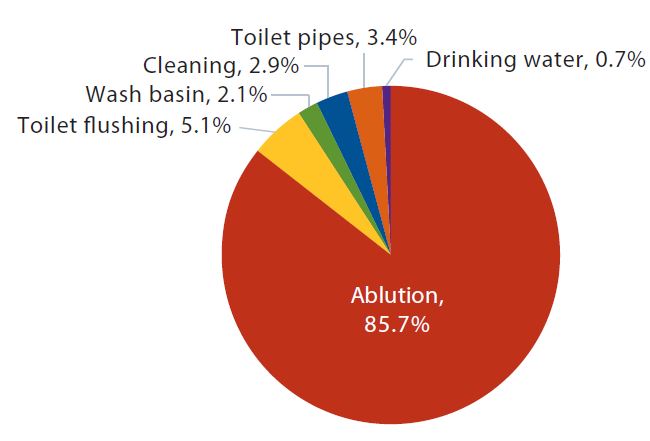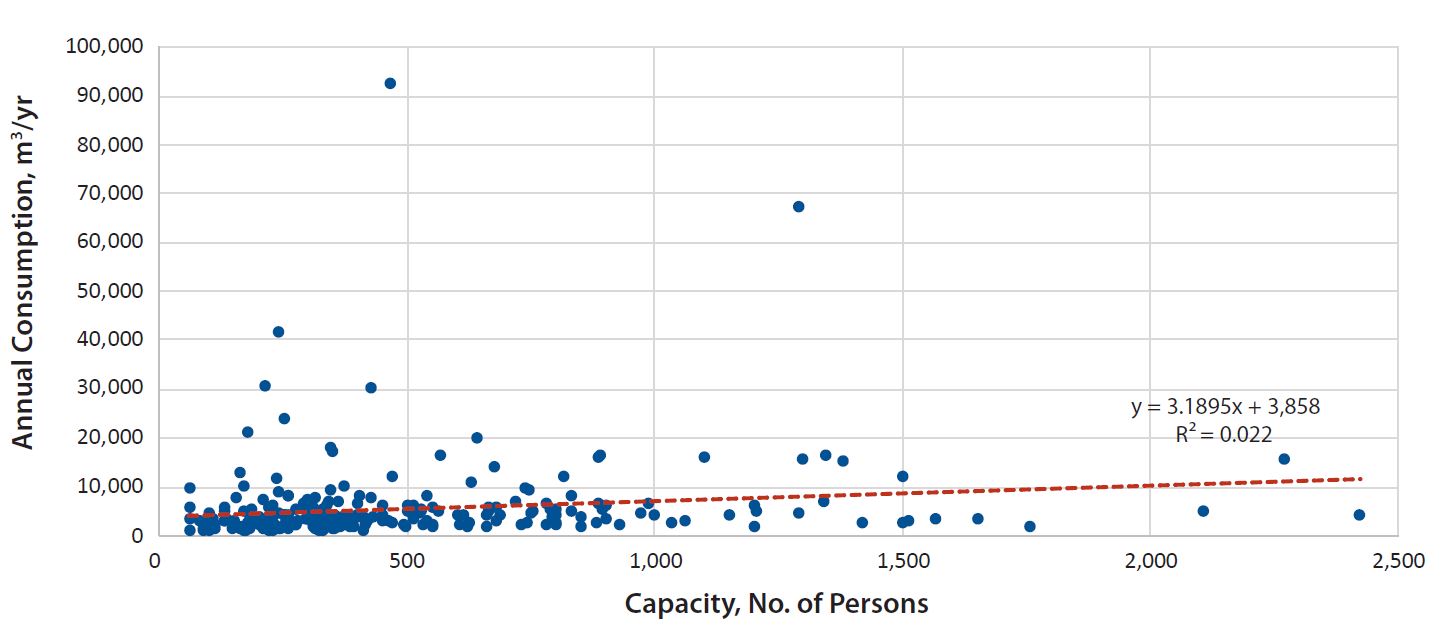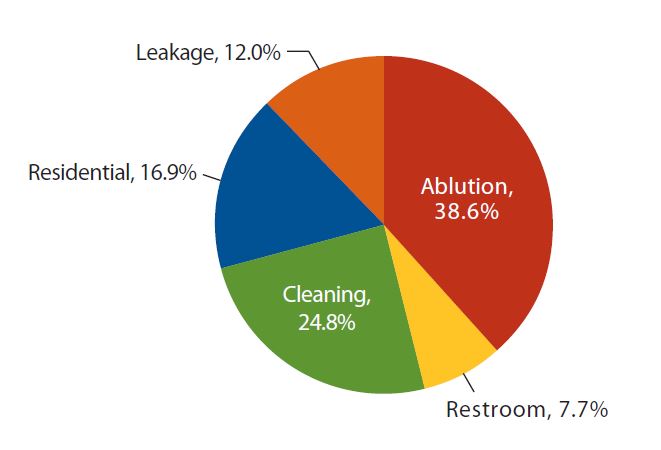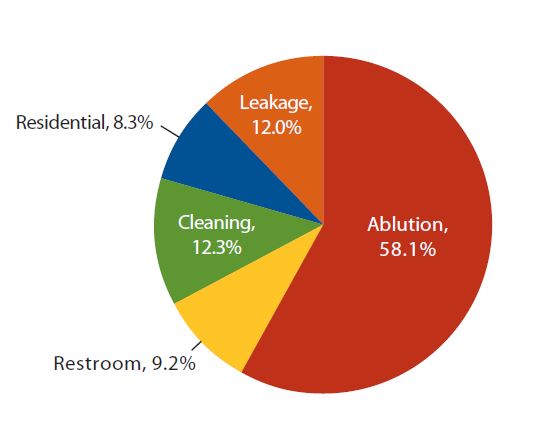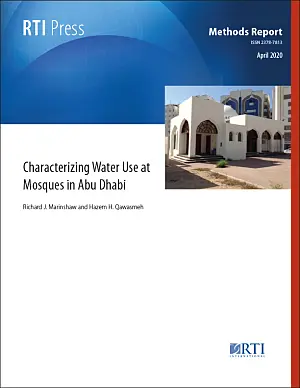Background
The Emirate of Abu Dhabi has approximately 1,900 public mosques, about 940 of which are located in the Abu Dhabi and Al Dhafra regions. Based on water meter data, these 940 mosques used about 6.2 million cubic meters (m3) of water in 2016; this represents about 1 percent of total potable water consumption for the Abu Dhabi–Al Dhafra regions that year (Abu Dhabi Distribution Company (ADDC), 2017). The Abu Dhabi government exempts mosques from utility charges (water and electricity), which creates little incentive for conservation.
Limited quantitative research appears to have been published in English worldwide on how water is used at mosques. The majority of studies available focus on the potential for reuse of gray water: ablution generates large volumes of gray water that can be readily used for landscape irrigation or toilet flushing with little or no treatment (Al-Mughalles et al., 2012; Al-Wabel, 2011; Instituting Water Demand Management in Jordan (IDARA), 2012; Prathapar et al., 2005; and Suratkon et al., 2014).
Instituting Water Demand Management in Jordan (IDARA) (2012) and Suratkon et al. (2014) include characterizations of mosque water consumption by various end uses. As shown in Figure 1, IDARA presents a breakdown (or water use profile) for mosques in Jordan for seven end uses: ablution, toilets, lavatory faucets, cleaning, showers, fountains, and landscaping. Ablution accounts for nearly 80 percent of total water consumption (due to rounding, the percentages add up to only 99.6 percent).
Figure 1.
44571Water use profile for mosques in Jordan
Source: Instituting Water Demand Management in Jordan (IDARA) (2012)
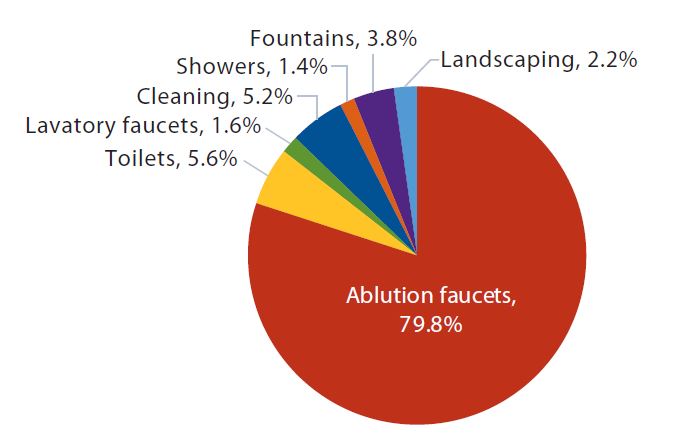
As depicted in Figure 2, Suratkon et al. (2014) reported typical values for water use by mosques in Malaysia for six end uses: ablution, toilet flushing, wash basins, cleaning, toilet pipes, and drinking water. In this case, ablution accounts for more than 85 percent of total water consumption.
The profiles shown in Figures 1 and 2 are comparable in that ablution accounts for the largest portion of water use by far, and each of the other end uses accounts individually for no more than about 6 percent of the water used. Neither profile appears to account separately for residential consumption or leakage, which, as discussed below, both account for significant water use at mosques in Abu Dhabi. It could be that leakage was accounted for within the totals for each end use (e.g., faucet leakage might have been included in the percentage of water attributed to faucet use).
End Uses of Water at Mosques in Abu Dhabi
Since 2015, the Abu Dhabi government has been implementing a demand-side management program to reduce consumption of water and electricity in the Emirate. In 2017, the government launched a mosque water conservation initiative (Masjidi) to reduce the consumption of water in mosques in Abu Dhabi by replacing existing ablution faucets with self-closing, low-flow faucets. Estimating the potential impacts of the initiative on total water consumption required a better understanding of how water is used at mosques. Before the government launched the Masjidi Initiative, it was assumed that ablution accounted for about 80 percent of the water used at mosques and this initiative would achieve large reductions in overall water use. However, as work proceeded, it became clear that other uses of water at mosques are significant. Thus, the reductions in water consumption from replacing ablution faucets were not nearly as high as expected.
Before full-scale implementation of the initiative, the Abu Dhabi Distribution Company (ADDC) conducted a pilot study at five mosques. The objectives of the pilot were to assess the performance of several types of high-efficiency faucets, better understand the logistics of faucet replacement, and better understand the various end uses of water at mosques (ADDC, 2016). Measurements of flow rates before and after the retrofits indicated that the high-efficiency faucets reduced flow rates by an average of 72 percent. However, a comparison of water meter data before and after retrofit showed an average overall reduction in water consumption of only 12 percent.
Based on learnings from the initial pilot, we developed a field report form for collecting the following data on each mosque to better inform estimates of savings following the installation of the new faucets: mosque name and location, water meter number, number of residents (persons living on the mosque grounds), number and type of faucets, leakage, measurements of flow rates from both the existing and new faucets, and cleaning practices. Based on the pilot project, we identified six primary water end uses: ablution, residential use, cleaning, restrooms, landscape irrigation, and leakage. The latter five are described in the following paragraphs.
Residential Water Use
Nearly all mosques in Abu Dhabi provide living quarters for the imam and his immediate family. At some locations, the moa’then (the person who calls for prayer) and custodian also reside at the mosque. Although water use in these residential units is not attributed directly to the mosque itself, the residences and mosque typically share the same water meter, so an analysis of water use based on water meter data must also account for residents’ use of water in the same manner as people in most residential units: for cooking, cleaning, bathing, washing clothes and dishes, and restroom use.
Cleaning
One of the more surprising findings from the Masjidi Initiative was the large volumes of water used for cleaning the mosque facilities—that is, the practice of washing down the mosque flooring and paved areas that receive frequent foot traffic. Many of the mosques, particularly the larger ones, are built to very high standards and feature large areas with marble or ceramic tile flooring in the ablution chambers and other areas that receive foot traffic. As a display of respect, the authorities are committed to maintaining the physical appearance of the mosque. Consequently, custodial staff are instructed to clean them multiple times each day, and the cleaning practices do not reflect serious consideration for water conservation.
The general cleaning procedure is to spray the mosque flooring with water, using the force of the spray to both clean surfaces and push the excess water off to where it can drain either to the sewer or to landscaped areas. Thus, the custodians usually select faucets with high flow rates, and it is not unusual for water to be run continuously for 1 to 2 hours each day during cleaning.
Restrooms
All mosques have restroom facilities. Although they are intended for worshippers, the restrooms also may be used by pedestrians and others in the vicinity of the mosque. The use of mosque restrooms by these other persons is of more significance in urban areas where there is much more pedestrian traffic and where there may not be other public restrooms in the immediate vicinity.
Landscape Irrigation
About 12 percent of the mosques in Abu Dhabi have landscaping, which may include palm trees, turf, shrubs, or other vegetation (ADDC, 2019). Due to the arid climate, any such vegetation must be watered regularly throughout the year. Depending on the size of the landscaped area, type of plant species, and the methods used, irrigation can use several thousands of cubic meters of water per year.
Leakage
Although not technically a water use, leakage was found to be a common problem in nearly all buildings with plumbing fixtures and connections, and mosques are no exception. We observed leakage from restroom faucets, toilets, ablution faucets, pipe connections, and water storage tanks at mosques in Abu Dhabi. Furthermore, with so many faucets that receive frequent use during much of the day, leakage can be substantial.
Methods
Data used for the analysis included information compiled by government entities and data collected on-site during the faucet retrofit process. The Abu Dhabi General Services Company (Musanada), which is a government entity contracted for maintaining public mosques, provided a database that included information on mosque design and construction. Musanada developed the database jointly with the General Authority of Islamic Affairs and Endowments (Awqaf). As noted previously, ADDC provided meter data on mosque water consumption. Musanada collected on-site data at the time of the faucet retrofits using the field report form we developed based on the findings of the pilot study. Data were collected on a total of 498 mosques from May 2017 to September 2018 (ADDC, 2019). However, not all of the mosques could be included in the analysis for reasons such as water meter discrepancies or missing data.
The mosques used for the analysis cover a wide range, in terms of both water consumption and worshipper capacity, which is the number of persons the praying area was designed to accommodate. The capacity of a mosque is based on the floor space of the praying area, with the assumption that each person requires about 1 m2. For the mosques analyzed, worshipper capacity ranged from 20 to 2,424 persons and annual water consumption ranged from just under 700 m3 per year (m3/yr) to more than 90,000 m3/yr (ADDC, 2019).
It seemed logical to define water use profiles based on worshipper capacity. However, as shown in Figure 3, a linear aggression analysis of the data indicated no significant correlation between capacity and water consumption—the square of the correlation coefficient (R2) had a value of 0.022.
Some specific examples are Mosque 621, which has a reported capacity of 421 persons, and Mosque 391, which has a reported capacity of 2,108 persons. The water meter data for Mosque 621 showed that consumption was about 30,000 m3/yr in both 2016 and 2017. However, Mosque 391, which has five times the capacity of Mosque 621, used an average of less than 5,000 m3/yr over the same period (ADDC, 2019). These results appear to indicate that the size of the mosque is not necessarily an indicator of water consumption by worshippers.
Other contributing factors may help explain the lack of correlation. For example, at some mosques, other users or facilities are connected to the mosque water line and recorded with the same water meter. Some examples are maintenance staff and contractors with offices and living quarters on the mosque premises, as well as shops that generate funding for the mosque through sales of goods and services (referred to in Arabic as waqf). Although the shops are usually connected to a separate water meter, the shopkeepers may be living on the mosque grounds or using the mosque water supply for various purposes.
Also, Qawasmeh & Ibrahim (2017) reported evidence of illegal connections at some mosques, with visible water piping running off the mosque premises to a nearby residence or other demand point. In addition, some mosques are located on the grounds of large residences with extensive landscaping, and in some cases, water recorded on the mosque water meter may have been used for irrigation or other purposes associated with the large residence. Finally, there were issues with how the water meter data were read and recorded. For some mosques, the monthly data included negative values or a period of one or more months with no consumption reported followed by a month with very high consumption reported. We assume that such cases were intended to correct for over- or undercharges, but the actual reasons for these anomalies are unclear.
Because worshipper capacity seemed to be uncorrelated with water usage, we based the mosque water use profile sizes on annual water consumption. We defined small mosques as those that use less than 2,400 m3/yr, medium mosques as those that use 2,400 to 8,000 m3/yr, and large mosques as those that use more than 8,000 m3/yr. These size ranges were somewhat arbitrary. A graphical review of the annual consumption data did not show any clear clusters or breakpoints except for large mosques, so the cutoff between the small and medium size ranges was selected to include roughly the same number of mosques within each group.
After we decided on the size categories, we determined the water use profiles using the available data on the mosques within each size category, combined with informed assumptions, to estimate the amount of water used by each of the end uses described previously. The basic approach was to first determine consumption for the end uses for which there were adequate data: (1) residential use, (2) landscape irrigation, (3) cleaning, and (4) leakage. The difference between total water consumption, as indicated by the meter data, and the combined consumption for these four end uses represents the consumption by the remaining two end uses: ablution and restrooms. Using data for ablution duration, faucet flow rate, and restroom faucet use, we could determine the number of ablutions. Once we estimated the number of ablutions, we could estimate consumption for ablution and restroom use. The following paragraphs provide additional details on the assumptions and methodology used.
Residential Consumption
Based on the data Musanada collected during faucet retrofit, the number of mosque residents ranged from none to 25 and averaged about 5 persons per mosque (ADDC, 2019). The number of residents was not necessarily consistent with the size of the mosque: several of the smaller mosques had eight or more residents, and several of the largest mosques had no more than five residents.
No data were available on per capita consumption by persons living at mosques. However, data from a 2014 Regulation and Supervision Bureau (RSB) study of 150 residential units in Abu Dhabi found that indoor water use averaged about 168 liters per capita per day (RSB, 2014). Since there were no indications that water use by mosque residents would be significantly different from that of the residents in the other study, we estimated residential water consumption using the data collected on number of residents at each mosque and the 168 liters per capita per day value.
Landscape Irrigation
The amount of water used for landscape irrigation is driven primarily by the climate, the size of the plot, types of plants, and irrigation method and practices. The impact of climate is accounted for through the reference evapotranspiration rate (ET0), which is known for Abu Dhabi as ET0 = 2,774.1 mm per year (Abu Dhabi Municipality, 2014). Data were available for the size of the landscaped area, but the other factors were unknown. Therefore, we needed a set of basic assumptions before we could approximate irrigation water use.
First, we assumed that a typical plot was an even mix of turf and palm trees, which is typical of many public places in Abu Dhabi. Even if portions of the plot were planted with shrubs or other non-native types of landscaping plants typically found in Abu Dhabi, the irrigation requirements would not be significantly different.
Although no information was available on the type of irrigation systems or the method for applying water to the landscaping, we assumed the irrigation efficiency to be 60 percent, which is often used as a typical operating efficiency for irrigation systems in the Emirate. The most common irrigation method at mosques in Abu Dhabi is manual irrigation, which generally is characterized as having relatively low efficiency. Based on these and other assumptions related to microclimate and plant density, we determined two irrigation rates: one for urban mosques, where the heat sink effect increases water demand, and one for rural mosques, where there is no heat sink effect.1
The factor with the greatest degree of uncertainty in the estimates of irrigation water use is the irrigation system efficiency. The actual efficiency for some irrigation systems may be as high as 90 percent for well-designed micro-irrigation systems properly installed and operated, or much less than 60 percent for systems that are poorly designed, poorly operated, or that have significant leakage in the irrigation lines.
The results for several of the mosques showed that the water consumption estimated for landscape irrigation exceeded the total consumption. In fact, even if we used an efficiency of 90 percent (i.e., there is very little wastage), the estimated irrigation water demand still exceeded the reported total annual consumption for several mosques. For this reason, we concluded that, in those cases, either the irrigated plot size was not nearly as large as reported or much of the plot was not irrigated. For this reason, we did not include mosques with irrigated landscaping in the dataset used to develop the final water use profiles described here. As noted previously, only about 12 percent of mosques have irrigated landscaping, and of the mosques with complete data needed for the analysis, only about 8.8 percent had irrigated landscaping (ADDC, 2019).
Cleaning
At the time of the faucet retrofits, Musanada recorded the number of times per day the ablution area is cleaned, the number of times per week that other areas of the mosque are cleaned, and the approximate duration (in minutes) for a typical cleaning. We assumed the water flow rate for cleaning to be the average flow rate (in liters per minute) for the existing faucets, which Musanada measured before retrofit. However, the information on cleaning frequency and duration that Musanada provided for many of the mosques was unrealistic. In addition, the reported cleaning durations and frequencies were often inconsistent with the size of the mosque. In some cases, as was the case with landscape irrigation, the reported cleaning data indicated that cleaning water usage exceeded the total water consumption registered by the water meter.
To resolve this issue, we conducted a field investigation to collect more accurate information on cleaning times and durations. We selected 17 mosques, representing a range of sizes (i.e., total floor space), locations, and types. At each mosque, we asked the cleaning staff to describe their daily and weekly cleaning practices in more detail, including the sources of water and duration of these tasks. Based on the data collected, we estimated cleaning durations as a function of the total floor space of each mosque, from 40 minutes per cleaning event for mosques with less than 120 m2 of floor space to 135 minutes per event for mosques with more than 1,000 m2 of floor space (ADDC, 2018). Cleaning water consumption was estimated as the total cleaning duration multiplied by the average flow rate for the existing faucets.
Leakage
No data were available on leakage rates at mosques. However, a 2014 study of 150 villas in Abu Dhabi found leakage to average 13.6 percent of indoor water use (RSB, 2014). Surveys conducted in the United States found leakage rates to average 4.4 percent for restaurants, 7.1 percent for hotels, and 15.9 percent for schools, but these average values were also based on wide ranges (American Water Works Association Research Foundation, 2000). For the mosques in Abu Dhabi, we assumed an average leakage rate of 12 percent. This is a typical value for residential and commercial facilities.
Ablution
Consumption of water for ablution is obviously a function of the number of worshippers who attend the call to prayer at the mosque, although not all worshippers conduct ablution at the mosque. However, mosque attendance is not routinely recorded in Abu Dhabi. Although mosques considered the idea of installing counters at mosque entrances, they concluded that doing so might be too intrusive. In the absence of data on attendance, we used a process of elimination to estimate water consumption for ablution (as well as for restroom use, which is discussed below). We summed the estimated consumption for residential use, cleaning, and leakage and subtracted this subtotal from total consumption; the remainder constituted consumption from the two remaining end uses: ablution and restrooms.
Both ablution and restroom consumption were assumed to be a function of the number of ablutions. We assumed that 20 percent of those who performed ablution at the mosque used the restroom. We estimated water consumption per ablution using data for faucet flow rate and the duration of ablution (i.e., the total amount of time that water is running during a single ablution activity). Faucet flow rate for a specific mosque was taken as the average of the flow rate measurements made immediately before installing the new faucets at the mosque.
Ablution duration was assumed to be an average of 2 minutes, based on a limited number of measurements we made at mosques in Abu Dhabi before faucet retrofit. Once we estimated the number of ablutions, we could estimate ablution consumption for the mosque using the average pre-retrofit faucet flow rate and average duration of 2 minutes.
Restroom Use
To estimate restroom use, we made assumptions about the water fixture usage rates and the percentage of worshippers performing ablution at the mosque who also use the restroom. As noted previously, we assumed that 20 percent of those performing ablution used the restroom. In addition, because mosques are public establishments, pedestrians and others working nearby with no easy access to restrooms sometimes use the restrooms out of convenience. We assumed that pedestrians and others increased restroom use by 10 percent for mosques in urban areas and by 5 percent for mosques in rural areas. Average toilet flush volume was assumed to be 11 liters per flush, based on a 2013 Executive Affairs Authority survey of buildings, including mosques, in Abu Dhabi (EAA, 2013). Faucet flow rate was assumed to be the average for the ablution faucets measured at the mosque, and we assumed that the restroom hand-washing faucets were used for an average of 15 seconds per person per visit.
We incorporated these assumptions into the equation we used to estimate the number of ablutions. Once we determined the number of ablutions, we could estimate restroom use as either the remaining volume (total consumption minus the consumption for all other end uses) or by using the number of ablutions and the water fixture usage assumptions.
Summary of Assumptions
Table 1 provides a summary of the assumptions used in the analysis.
Table 1.
44574Summary of Assumptions Used in Analysis
Results
Within each size group, we used the data to calculate the percentage of consumption for each of the six end uses described above. Figures 5 to 7 show the distribution for small, medium, and large mosques, respectively. Small mosques are those that use less than 2,400 m3/yr, medium mosques are those that use 2,400 to 8,000 m3/yr, and large mosques are those that use more than 8,000 m3/yr. As would be expected, the percentages of consumption for ablution and restrooms increase from small to large mosques, as a progressively smaller percentage of consumption is used for the other end uses (except for leakage, which is held at 12 percent). Irrigation was excluded because less than 12 percent of mosques in Abu Dhabi have irrigated landscaping, and for those that do, there is a very wide range in area landscaped. Instead, for mosques with irrigated landscaping, irrigation consumption can be estimated separately based on the design of the system and the watering schedule.
Table 2 summarizes the results for the three mosque sizes in Abu Dhabi along with the data reported for mosques in Jordan and Malaysia. For the Abu Dhabi mosques, the percentage for ablution is highest for large mosques but still significantly less than the percentages for the mosques in Jordan and Malaysia. For Jordan, the “Other” end use category includes landscaping, showers, and fountains. For Malaysia, the “Other” category represents drinking water.
Table 2.
44575Summary of water use profiles for mosques
a Includes landscaping, showers, and fountains.
b Drinking water.
c Due to rounding, percentages do not add up to exactly 100%.
Table 2 also shows the overall profile based on all of the Abu Dhabi mosque data irrespective of size. The overall profile is very similar to the profile for medium size mosques.
Sensitivity Analysis
The assumption of 2 minutes as the average duration for ablution is higher than the values reported for other countries for similar types of manually operated faucets. Zaied (2017) found that the average ablution duration at mosques in Saudi Arabia varied from about 43 seconds to 60 seconds, depending on the type of faucet. Radin Mohamed et al. (2016) reported durations at mosques in Malaysia that ranged from 42 seconds to 59 seconds and averaged 49 seconds. Finally, Al-Mughalles et al. (2012) reported that durations measured at mosques in Yemen ranged from 23 to 108 seconds and averaged 58 seconds. We do not know whether the difference in ablution time is due to cultural differences or whether additional measurements in Abu Dhabi would have indicated an ablution duration that is more consistent with the durations measured elsewhere. If the average duration were reduced to 1 minute per ablution, the estimated number of ablutions would increase, as would the restroom consumption, but the overall ablution percentage would decrease. Table 3 shows the resulting breakdown for all end uses.
Table 3.
44576Water use profiles for mosques using ablution duration of 1 minute
The estimated consumption for restrooms was based on several assumptions, the most significant of which was that 20% of mosque worshippers would use the restroom. Although 20 percent seems reasonable, the actual percentage could be significantly lower or higher. Table 4 shows the results if the percentage of restroom users was reduced to 10 percent.
Table 4.
44577Water use profiles for mosques assuming 10% of worshippers use restroom
Another factor that impacts water end use breakdown is the presence of high-efficiency fixtures. Most of the existing mosques in Abu Dhabi were not fitted with high-efficiency fixtures. Based on measurements taken at the time the new ablution faucets were retrofitted, the old faucets had an average flow rate of 15.2 L/min, and the median flow rate was 10.3 L/min (ADDC, 2019). The current standard for high-efficiency faucets in Abu Dhabi is a flow rate of 6.0 L/min or less (Abu Dhabi Quality and Conformity Council (QCC), 2014). Existing toilets were assumed to have an average flush volume of 11.0 liters per flush (L/flush; EAA, 2013); the current standard for high-efficiency toilets is 6.0 L/flush (QCC, 2014). We assume that cleaning volumes would not change and average leakage rates remained at 12 percent; Table 5 shows the resulting end use profiles for mosques using all high-efficiency fixtures.
Table 5.
44578Water use profiles for mosques assuming all high-efficiency fixtures
When compared with the profiles shown in Table 2, which represented the situation before retrofitting any additional high-efficiency fixtures, the percentages for ablution decrease from 38.6 to 30.5 percent for small mosques, from 58.1 to 46.6 percent for medium size mosques, and from 70.2 to 68.7 percent for large mosques. The percentages for restroom use also decrease from 7.7 to 5.3 percent for small mosques, from 9.2 to 7.5 percent for medium, and from 13.3 to 11.3 percent for large mosques. These decreases are offset by increases in the percentages for cleaning and residential use.
Conclusions
We developed water use profiles for three sizes of mosques. If total consumption is known (e.g., from water meter readings), the profiles can be used to estimate the amount of water for each of five end uses: ablution, restrooms, residential use, cleaning, and leakage. If a mosque has irrigated landscaping or other significant end uses of water, those end uses of water should be quantified first, before applying the profiles to the remaining consumption (e.g., total consumption minus consumption for irrigation). Having a breakdown of water consumption by end use can help determine which specific end uses to target for demand-side management and water conservation programs. The profiles can also be instrumental in estimating the expected savings in water consumption from such programs.
The profiles indicate that ablution consumption in Abu Dhabi is lower than what has been reported for mosques in other regions. One of the primary reasons for this result is the large amounts of water used in Abu Dhabi for cleaning, which accounts for at least 1,000 m3/year at several mosques (ADDC, 2019). Leakage is another important consideration and appears to have been left out of the water end use analyses reported from other studies. However, leakage is nearly always an issue, especially when large numbers of fixtures are in use throughout the day, as is the case with mosques. For this reason, leakage should be investigated and quantified to the extent possible whenever evaluating water use at mosques.
Some of the key factors that should be investigated further are mosque attendance, ablution duration, faucet flow rates, cleaning water consumption, leakage, which was discussed previously, and use of mosque restrooms by pedestrians and others who are not attending the call to prayer. Having accurate data on attendance would eliminate a lot of the uncertainty associated with estimating ablution consumption. The ideal situation would be to install a separate water meter to measure the ablution faucets, but that may not be economically feasible or practical for many mosques.
Ablution duration is another factor that is critical for determining how much water is used for ablution. Additional measurements in Abu Dhabi are needed to either support the higher durations indicated by the data used in the analysis or the lower durations reported for other regions.
Although flow rates were measured for a representative number of the existing faucets at each of the mosques, not all faucets were measured, and there was a very wide range in flow rates, both across mosques and within mosques. The average flow rates ranged from under 2 L/min to about 60 L/min, and at several mosques, one faucet had a flow rate more than five times the flow rate of other faucets at the same mosque. If worshippers gravitate toward faucets with the highest flow rates, the average flow rates used in this analysis might be biased low. On the other hand, the flow rates were measured with the faucets fully open, and we do not know whether users typically open the faucets all the way during ablution. If worshippers typically open the faucet just enough to get an adequate stream of water, the measured flow rates may overestimate the flow rates for ablution at some mosques.
Estimates of cleaning consumption were based on interviews with custodial staff. Actual measurements of water flow rates and cleaning durations would help to corroborate the estimates provided. Similarly, counting the number of non-worshippers who use mosque restrooms would help refine how much water is used and under what conditions that usage is significant.
